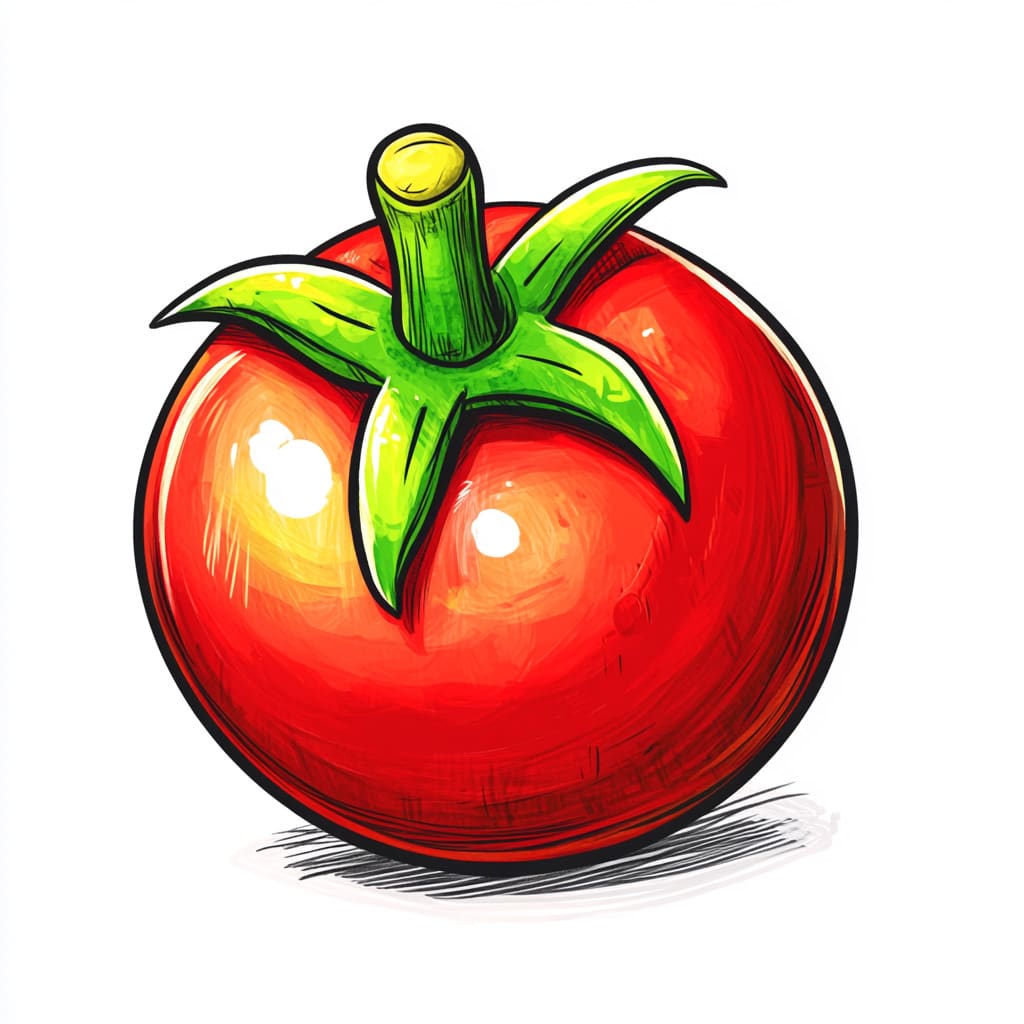
Drawing is not merely a skill; it is a form of expression that allows you to bring your imagination to life. Whether you’re capturing the beauty of a landscape, sketching your favorite person, or illustrating a simple fruit, each mark you make on paper reflects your unique artistic voice. Today, we will delve into the delightful world of drawing as we learn to create a realistic representation of a tomato.
This step-by-step guide is designed for everyone—whether you are a complete beginner or an experienced artist looking to refine your skills. As we progress, I will provide clear and concise instructions that will help you understand the nuances involved in drawing a tomato. From understanding the basic shapes to incorporating intricate details, this tutorial will equip you with the tools you need to create a stunning depiction of this vibrant fruit.
So, gather your materials and prepare to immerse yourself in the creative process. Drawing is about more than just the final result; it is an opportunity to explore and enjoy what you can create. Let’s roll up our sleeves, sharpen our pencils, and get ready to bring a succulent tomato to life on the page!
Materials Required
Before we begin, make sure you have the following materials:
- Paper: Use a smooth, heavyweight paper that is suitable for drawing. You can use either a sketchbook or loose sheets of paper.
- Pencils: I recommend using a range of graphite pencils, such as 2H, HB, 2B, and 4B. These different grades will allow you to achieve a variety of tones in your drawing.
- Eraser: Have a kneaded eraser or a soft eraser on hand to correct any mistakes or lighten areas of your drawing.
- Blending tools: You can use a blending stump or a paper towel to smooth out the shading in your drawing.
- Reference image: It’s helpful to have a reference image of a tomato in front of you. You can find one online or use a photo you have taken.
Now that you have all your materials ready, let’s begin!
Step 1: Basic Shape
Start by lightly sketching a rough outline of the tomato. Use basic shapes to guide you. To begin, draw an oval shape for the body of the tomato. Keep it fairly loose and don’t worry about the details just yet.
Step 2: Stem and Leaves
Now, let’s add the stem and leaves of the tomato. Draw a slender curve extending from the top center of the tomato for the stem. Then, add a few jagged lines on either side to represent the leaves. Remember to keep the lines loose and light to allow for adjustments later on.
Step 3: Refine the Shape
Next, focus on refining the shape of the tomato. Look closely at your reference image and observe the subtle curves and contours. Use light, curved lines to outline the tomato, paying attention to its unique shape. Take your time with this step, as it will set the foundation for the details to come.
Step 4: Shading the Tomato
Now it’s time to add some depth and dimension to your tomato drawing. Start by shading the areas that are in shadow. Using a 2B or 4B pencil, gently shade the areas that are on the underside of the tomato. Gradually build up the shading, making it darker as you move towards the center of the tomato.
Step 5: Highlight and Midtones
To create a realistic tomato, we need to add highlights and midtones. Using an HB or 2H pencil, lightly shade the areas of the tomato that are receiving direct light. Leave some white spaces to represent highlights. Blend the shading using a blending stump or a paper towel to smooth out any harsh lines.
Step 6: Texture and Details
Now it’s time to add texture and details to your tomato drawing. Observe the texture of a real tomato and try to replicate it using short, curved lines. Use a variety of pencils to achieve different tones and textures. Darken the shadows even further, adding depth and dimension to your drawing.
Step 7: Stem and Leaves Details
Let’s now focus on adding details to the stem and leaves. Use light, short strokes to create the texture of the stem. Add veins and serrated edges to the leaves, paying attention to the reference image for guidance. Remember to keep your lines loose and organic to mimic the natural appearance of the stem and leaves.
Step 8: Final Touches
Take a step back and assess your drawing. Are there any areas that need adjustment or refining? Use an eraser to lighten any areas that need more highlights or to correct any mistakes. Make any necessary adjustments to ensure your tomato looks realistic and three-dimensional.
Conclusion
Congratulations, you have successfully drawn a realistic tomato! Drawing takes practice, so don’t be discouraged if your first attempt doesn’t turn out exactly as you hoped. The key is to keep practicing and refining your skills. Remember to have fun and enjoy the process of creating art. I hope this step-by-step guide has been helpful in teaching you how to draw a tomato.
Fun Facts About Tomatoes
- Variety and Origin: There are over 10,000 varieties of tomatoes worldwide. They originated in South America, specifically Peru.
- Fruit or Vegetable?: Tomatoes are classified as a fruit because they grow from a flowering plant and contain seeds.
- La Tomatina Festival: Every August, the town of Buñol in Spain hosts La Tomatina, the world’s largest tomato fight.
- Nutritional Value: Tomatoes are rich in vitamins A and C, potassium, and calcium. They also contain lycopene, an antioxidant linked to reduced heart disease and cancer risks.
- Production: China is the largest producer of tomatoes globally, followed by the United States.
- Record-Setting: The Guinness World Records lists the heaviest tomato as weighing 7 pounds 12 ounces.
- Space Growing: Tomato seedlings have been grown in space, demonstrating their adaptability.
Suggestions for Scenes and Settings for Tomato Drawings
- Tomato Garden Patch: Sketch a vibrant scene of tomatoes growing in a sunlit garden, with vines curling around wooden stakes and bees buzzing nearby.
- Market Day: Illustrate bustling market stalls overflowing with various types of tomatoes, with vendors arranging their colorful displays.
- Italian Feast: Picture a rustic kitchen setting with tomatoes and basil scattered on a wooden table, ready to be made into a classic tomato sauce.
- Tomato Circus: Design a whimsical scene where tomatoes perform tricks in a circus tent, balancing on tightropes and being juggled by clowns.
- Underwater Paradise: Create an imaginative underwater world where tomatoes float like jellyfish, with fish weaving through the vine-like stems.
- Tomato Time Traveler: Show a tomato experiencing historical eras, from ancient Roman feasts to futuristic space meals.
- Sunset Salsa: Depict a lively scene with tomatoes dancing in pairs under a setting sun, while peppers and onions play musical instruments.
- Tomato Cafe: Picture a cozy sidewalk cafe where tomatoes sip coffee and read the newspaper, enjoying a leisurely afternoon.
- Fantasy Tomato Tree: Invent a fantastical tree that grows tomatoes instead of apples, with birds nesting in its branches.
- Tomato Village: Imagine a charming countryside village where the houses are shaped like tomatoes, complete with leafy rooftops.









